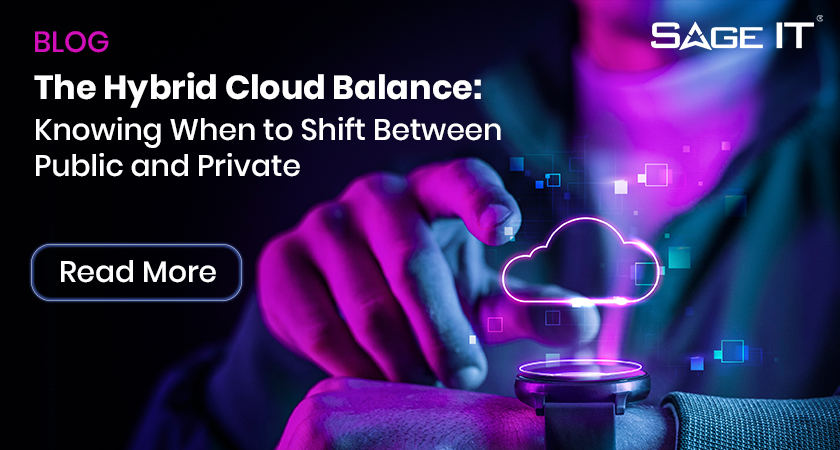
In the last couple of years, there has been an increased discussion among companies using the hybrid cloud strategy about taking their workloads off the public cloud. There is an imminent shift in the industry; many are weighing their options to establish a cloud balance. A 2019 Gartner survey says 4% of users have found a need to move their public cloud workloads to private.
It can be challenging to know which type of cloud computing model to adopt. This is usually different depending on the industry, functions, stage, or several other factors that can influence the decision. Check below as we will examine it from top to bottom, determining the best case for your business.
But first, let us start at the beginning and examine the various types of cloud.
Types of Cloud
The significant types of cloud are public, private, and hybrid. We will examine each below along with its unique benefits and drawbacks.
Public Cloud
A public cloud is a service that offers virtualized computing resources managed by a third-party provider and delivered over the internet. Some of the resources provided include storage, networking, servers, applications, etc. Some of the major public cloud providers are AWS, Azure, and Google Cloud Platform (GCP).
Benefits of Public Cloud
Easy Setup: It is pretty straightforward to use a public cloud platform when compared to the others. There is no need to associate the Application Packaging Standard (APS) to the cloud key or the cloud key to a cloud account. You can simply create an account with a subscription and start using it.
Great Pricing: Public cloud platforms have flexible pricing options based on their service level agreements. It is also pay-as-you-go, so you will only pay for the resources you consume.
Reliable: Public clouds do not have a single point of failure, and it is very flexible. It seamlessly integrates with many third-party systems and applications to give you several features to choose from, depending on your preference.
On-Demand Scalability: Because of the vast resources on public cloud platforms, you can quickly scale up to meet increasing demand and scale down during off-peak periods.
Zero-touch provisioning: It supports zero-touch provisioning, making it easy to provision, get additional resources and configure devices automatically.
Drawbacks of Public Cloud
Supports only General Needs: Its options are one-size-fits-all, which means if you have unique needs or complex application processes, it may not be sufficient for you.
Security: Data privacy and security are a concern for many organizations. It is essential to implement your privacy and security directives in your architecture.
Compliance Challenges: Cloud providers and other companies that handle confidential data are subject to government regulations, leading to compliance challenges with an organization.
Private Cloud
A private cloud provides the same virtualized and elastic resources a public cloud can offer, except it is usually dedicated for use by one organization. Typically, the organization will handle the management of these resources or outsource its management. Private clouds either reside on-premises or it is operated offsite.
Benefits of Private Cloud
Security: Since the organizations handle security themselves, they are usually more confident about data privacy and security.
Regulation Compliance: Organizations can build their infrastructure and architecture around legal, compliance, and security requirements in a way that suits them most.
Flexibility: Organizations can quickly adapt to their changing needs since the environment is theirs. In evolving technology, market needs, or opportunities, they can position themselves in a favorable position.
Drawbacks of Private Cloud
Cost: Building your own dedicated private cloud infrastructure is very capital intensive. An alternative to this is renting a private cloud from hosting service providers.
Limited Remote Access: Because of the increased level of security that affects mobile users primarily in the private cloud environments, there is limited remote access to the services. These mobile users may not connect to the necessary business functions they want.
Long rollout time: It takes a lot of resources and time to deploy a private cloud infrastructure, especially globally.
Hybrid Cloud
A hybrid cloud is the combination of private and public cloud infrastructure for an organization. Hybrid clouds also include technology that enables IT teams to orchestrate workloads across all the cloud services seamlessly. This allows the organization to have a standard set of tools for your public, private, and edge cloud platform making it easier to manage cloud resources.
Benefits of Hybrid Cloud
Best of Both Worlds: You get to enjoy the benefits of both private and public cloud platforms while improving your infrastructure and functionality.
Agile: You can quickly adapt your private and public infrastructure to meet changing needs and opportunities. It also allows you to modernize legacy applications with time.
Compliance: You can use your equipment to the best capabilities and balance between security requirements simultaneously.
High Flexibility: Your operations can respond far quicker to unpredictable demand changes in the market. You can use the public cloud in response to a demand increase without any effect on the workloads on the private cloud.
Drawbacks of Hybrid Cloud
Extra Hardware: Hybrid approach increases the amount of hardware you have to deploy because of devices for remote control and data storage.
Single Point of Failure can Affect Entire Infrastructure: Any single element of failure can destabilize the entire configuration and remove the visibility of the hybrid cloud.
Complicated Architecture: It could be challenging to navigate hybrid cloud architecture, especially for newcomers to the organization. Managing several security platforms can also be challenging.
Establishing The Balance Between Private and Public Cloud in a Hybrid Infrastructure
As seen above, no single cloud type is the best as each has its advantages and drawbacks. However, different companies have unique models and operations in place. Many organizations running on the hybrid model have become increasingly disillusioned with the public cloud. Often, many organizations may need to move to the public or private cloud more due to several business reasons and optimizing workloads. Some of these factors are:
Inadequate Skills
Managing workloads efficiently in a private cloud requires in-depth knowledge of performance reporting, cloud architecture, deployment, etc. On the other hand, public cloud platforms have automation tools to help navigate this hurdle.
Businesses or organizations with a shortage of skills might not have the option to go for private cloud or on-premises environments because managing their workloads will be a challenge. The public cloud presents a better alternative since there are automation tools already available.
Cutting Costs
You can use the cloud to automate processes built on top of cloud infrastructure layers for more efficiency. Only relying on cuts in upfront investments and flexible hybrid cloud infrastructure operating costs matching the business growth will not strain the business as it expands. However, businesses cannot initially scale – except they’re in the public cloud.
If scaling the business is the essential factor for a company to use the public cloud, once it reaches a certain point, they may consider moving part or all of their workloads to private clouds to save costs.
Safety Convenience
Many of the operations running on the public cloud are primarily automated with minimal human intervention. This model ensures there is a high level of security and no errors are in the setup. Many companies will find that cloud security has several options that are challenging to access because of cost.
Cloud-based security teams and services are typically pre-configured, and if the company decides to use a different setup, there aren’t many options. This makes it easier to use private clouds, especially for healthcare organizations and banks, because of reporting requirements, data sensitivity, and regulatory environments.
Increasing Availability and Latency
Unavailability of public cloud services is very rare, but if they were to occur, it could cause many disruptions in operations. For so many public cloud platforms, their only option is to wait for the services to come back online. This is different with an on-premises data center or private cloud as they have better control over downtime and availability.
In organizations with large, geographically dispersed user bases, latency is a factor. A company might use a hybrid cloud model hosting some of its content and user database in a public cloud and still use a private delivery network.
Hybrid Cloud Management Across Different Cloud providers and On-prem
Managing multiple cloud environments can be challenging, especially if the user isn’t familiar with how it works. Learning how to manage cloud deployments on public clouds along on-premises environments can be tricky. Hybrid cloud environment management tools make this task easier as organizations find a balance between public cloud and private cloud.
Tools For Hybrid Cloud Management
There are four prominent and popular tools used for hybrid management across public and private clouds. Check them out with their basic features.
Cloudify: It uses a model-driven cloud management system. In this case, you define the desired state of cloud applications workload, and the system automatically deploys it on the specified cloud. It has tools for powerful automation and abstraction of cloud resources to make it convenient to automate configuration and deployment across clouds. You can use Cloudify to set your SLA policies and ensure your workloads adhere to service levels.
OpenStack: OpenStack offers network as a service, auditing, security posture, and orchestration. It seamlessly integrates with all the major public cloud providers as well as popular enterprise technologies. You can also choose from a broad selection of open-source tools and OpenStack projects.
ManageIQ: It is a system of hybrid IT management of legacy private cloud and public cloud environment. Supports all the main features on public cloud environments, including containers, virtual machines, and other services. You can also use its robust monitoring and performance optimization tools for maximum performance.
Apache CloudStack: The tools on Apache CloudStack include compute orchestration, user & account management, networks (network as a service), and security. Supports a broader range of hypervisors, including KVM, Citrix, and VMware.
Capabilities of Hybrid Cloud Management Tools
Many of these hybrid cloud management tools offer the same services such as:
Workload and Cost Analysis: Providing actionable insights into everything running on your hybrid cloud model and the cost implications. It allows you to choose the options with lower cost implications for better efficiency.
Service Aggregation: Displaying the applications and services running on the different cloud environments in one place so you can plan and manage them as one unit.
Workload Migration: Hybrid cloud management tools give you fast, low-risk, and automated options for transferring your hybrid cloud workloads from private to public cloud environments and move as you wish.
Integrations and APIs: With these tools, you can conveniently integrate your hybrid cloud environments with your existing enterprise systems and development tools, whether they’re on the cloud or on-prem.
Manage Costs: This allows you to set flexible cost management methods and policies across cloud solutions and maximize your ROI by choosing cheaper solutions for your services.
Conclusion
Moving workloads from the public cloud is not a general choice, and this varies by organization depending on the cloud maturity and architecture of a company. Depending on how the company evolves and their needs, they may use the public or private environment more at different points in their journey.

Satya Govindu
Chief Delivery Officer, Sage IT









